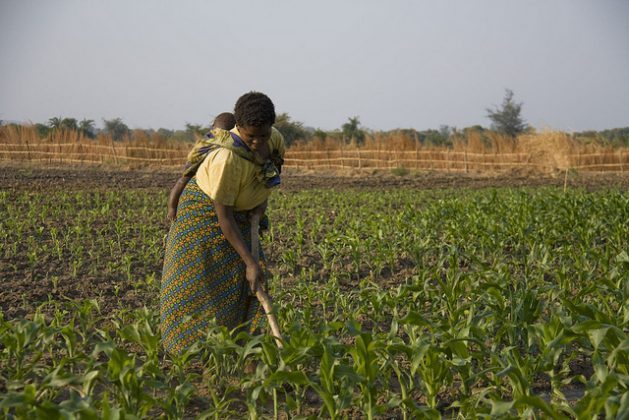Thursday, April 18, 2024
News and Views from the Global South
Food and Agriculture
Livelihoods of Almost Half the World’s Population Depend on Agrifood Systems

The 1.23 billion people working in agrifood systems belong to households made up of an estimated 3.83 billion people. Credit: Kristin Palitza/IPS
- New research by the United Nations Food and Agriculture Organization (FAO) has revealed that almost half the world’s population of around eight billion people belong to households whose livelihoods depend to some degree on agrifood systems (AFS).
The findings are important as farming and the food system as a whole is central to the multiple challenges humankind faces to feed a global population forecast to rise to 10 billion by 2050, while meeting the Sustainable Development Goals to end poverty, hunger and malnutrition, combat the climate crisis and preserve natural resources for future generations.
So the research offers precious information for decision makers, and FAO is aiming for it to be the start of an ongoing statistical data series.
The 1.23 billion people working in agrifood systems belong to households made up of an estimated 3.83 billion people.
FAO says there is evidence of a high degree of exploitation of labour in agrifood systems, including harmful conditions, precarious job security, low wages, disproportionate burdens on women, and coercive use of child labour.
So statistics on the number of people employed in AFS can be useful to monitor for violations of human rights and to develop and target policies to regulate working conditions in the sector.
Agrifood systems also present opportunities though, as they can offer many new jobs, a factor that is especially important in lower-income countries with lots of young who need employment.
So the data can help to shape policies to develop these opportunities.
For example, better understanding of the existing workforce could reveal entry points for programmes to increase skills and entrepreneurship.
“Identifying and quantifying the number of agrifood-system workers is essential for several reasons, particularly for low- and middle-income countries of the Global South,” Ben Davis, the Director of FAO’s Inclusive Rural Transformation and Gender Equality Division, told IPS.
“In low-income countries, the largest number of workers are employed in agrifood systems, and agrifood systems are a key economic motor of growth and poverty reduction,” added Davis, the lead author of the study, which is entitled Estimating Global and Country Level Employment in Agrifood Systems.
“Agrifood-system transformation offers the promise of new jobs in both agriculture and the off-farm segments of agrifood systems, particularly in low income countries with large, young populations.
“Deliberate policies, however, are needed to ensure the quantity and quality of these jobs.
“Statistics on the number of people employed in agrifood systems would also help regulate working conditions and develop and target appropriate policies and programmes to support livelihoods”.

The three challenges facing agrifood systems – feeding a growing population, providing a livelihood for farmers, and protecting the environment – must be tackled together because, given the many interconnections, taking a single-issue perspective on any objective can lead to unintended impacts on others. Market in Rome. Credit: Paul Virgo / IPS
The new report said that the continent with the largest number of people employed in agrifood systems is Asia with 793 million, followed by Africa with almost 290 million
It said the majority of the economically active population in low-income countries, particularly in Africa, had at least one job or activity in agrifood systems.
It said that 62% employment in Africa is in AFS, when relevant trade and transportation activities are included, compared to 40% in Asia and 23% in the Americas.
The study said that, of the 3.83 billion people belonging to households reliant on agrifood systems for their livelihoods, 2.36 billion live in Asia and 940 million are in Africa.
The study is the first to give a systematic, documented global estimate of the number of people involved in AFS.
It said the number of people engaged in the sector has been undercounted in the past due to three factors.
The first is that many people, especially those living in poverty, work several jobs and lots are involved in AFS, even if this is not their primary activity.
The second is that many AFS jobs are seasonal or intermittent and so easily missed by surveys.
Finally, many people are engaged in household farming for their own consumption on top of their primary occupation.
The report gives the example of a full-time schoolteacher who grows produce for sale on their land.
Agrifood systems produce some 11 billion tonnes of food worldwide each year, the FAO says.
But they also have a big environmental footprint.
The IPCC’s recent Synthesis Report, which completed its Sixth Assessment cycle, said that 22% of global greenhouse gas emissions currently stem from agriculture, forestry, and land use.
Without radical change, the world is set for a future of persistent food insecurity and the destruction and degradation of natural resources.
Building sustainable, resilient agrifood systems, on the other hand, can help tackle the climate crisis, biodiversity loss and food insecurity.
FAO has presented a Strategy on Climate Change, which argues that a holistic approach is needed.
It says the three challenges facing agrifood systems – feeding a growing population, providing a livelihood for farmers, and protecting the environment – must be tackled together because, given the many interconnections, taking a single-issue perspective on any objective can lead to unintended impacts on others.

 Print
Print



